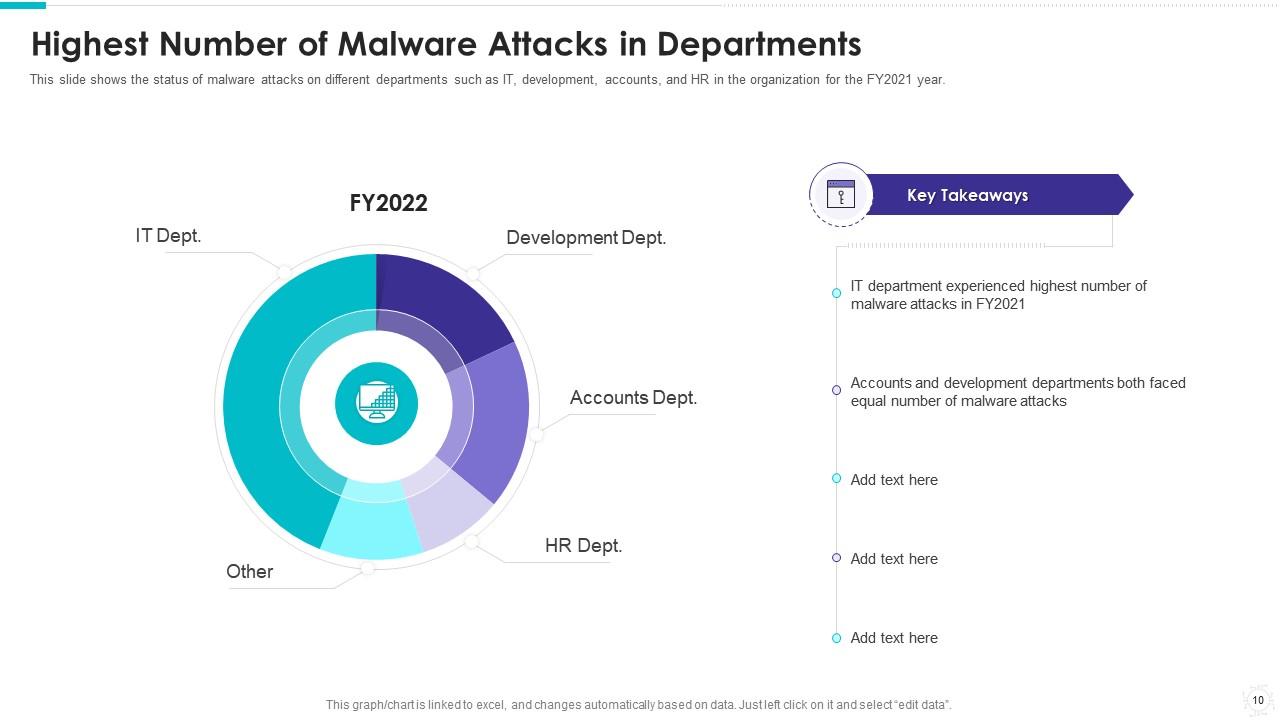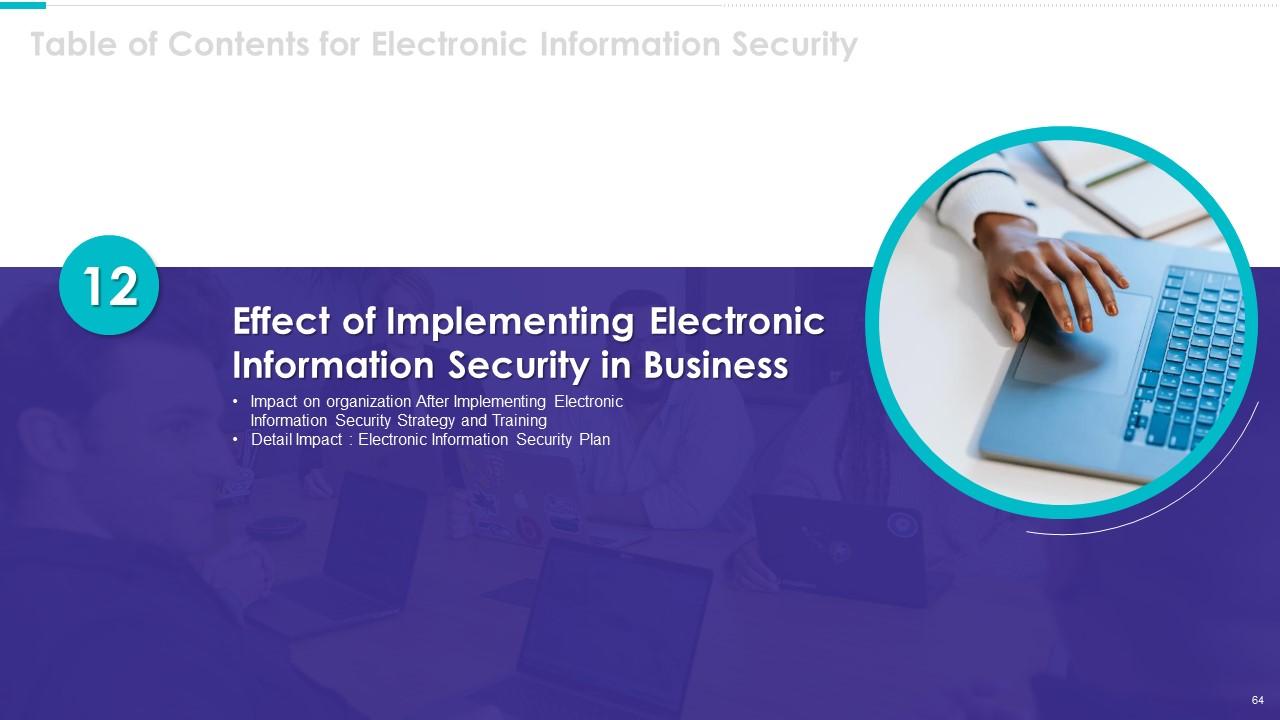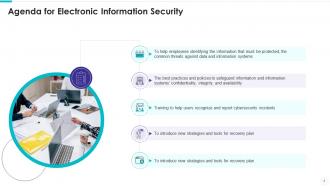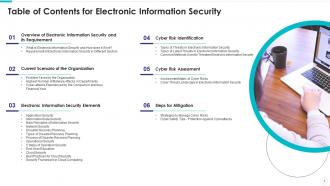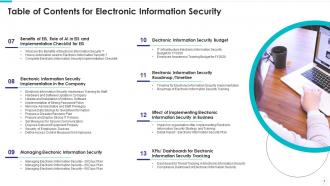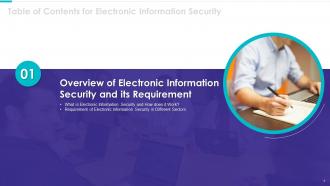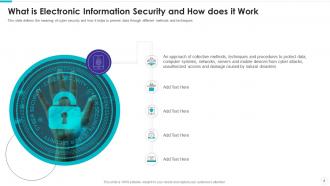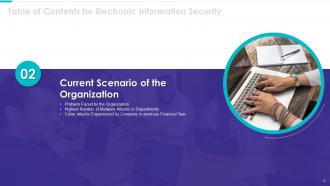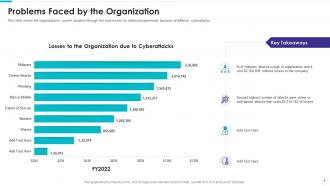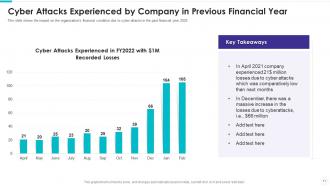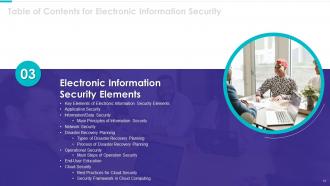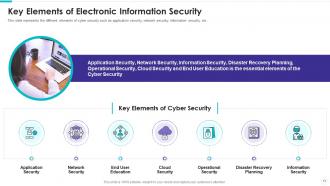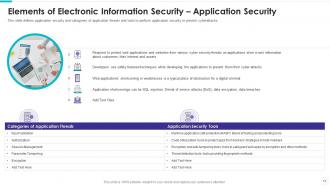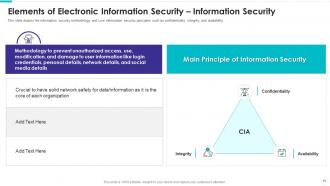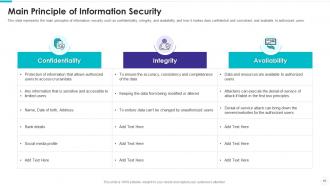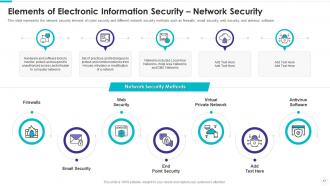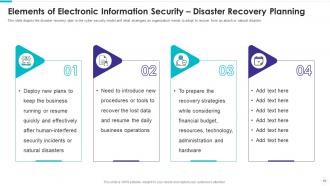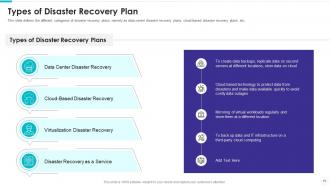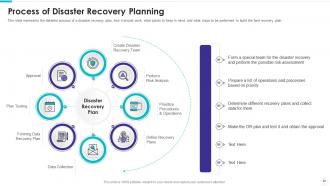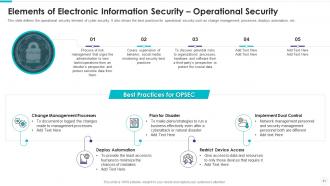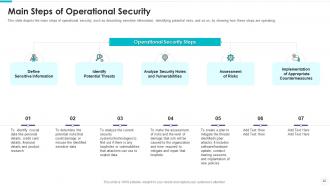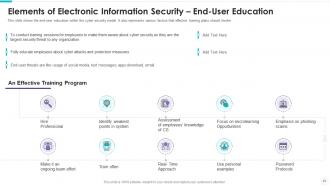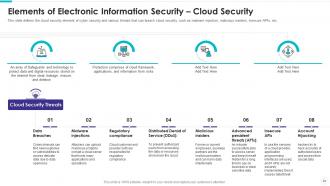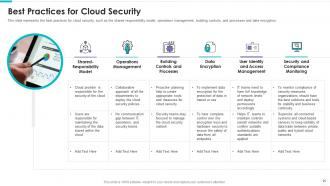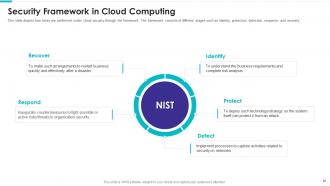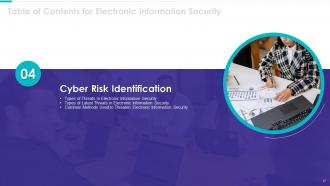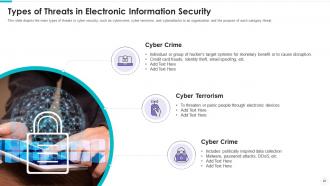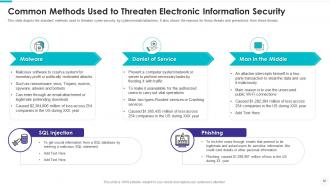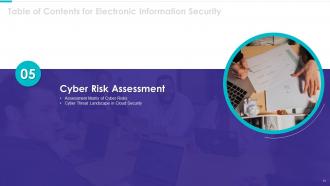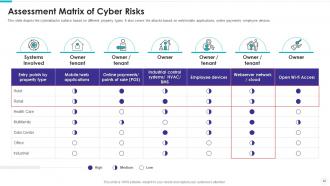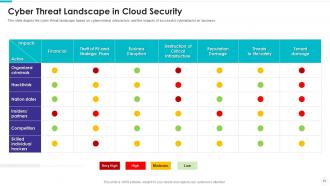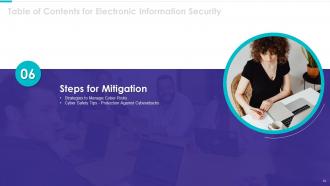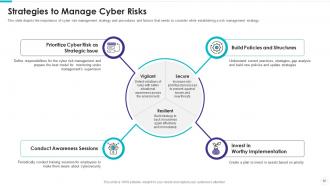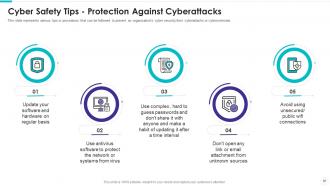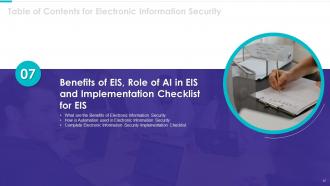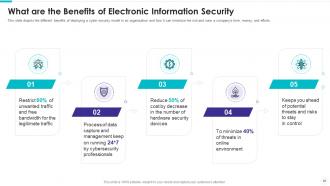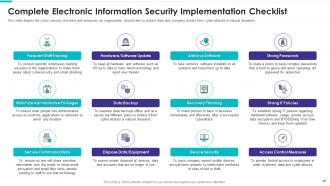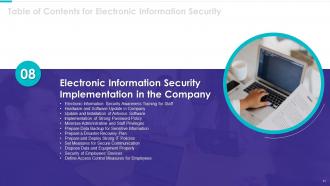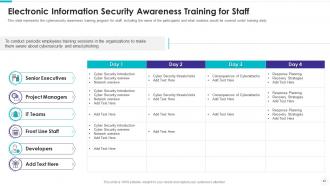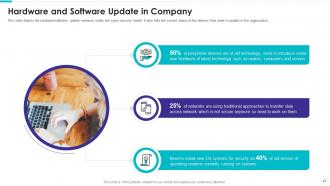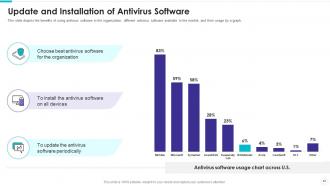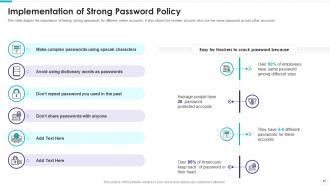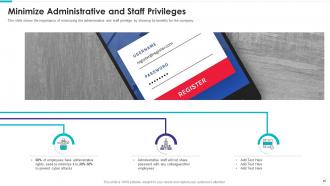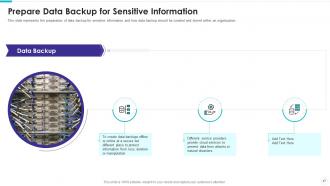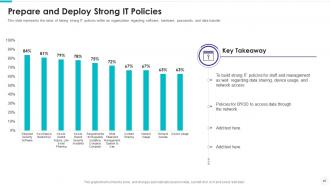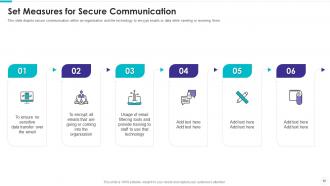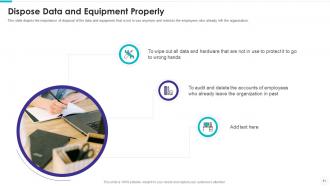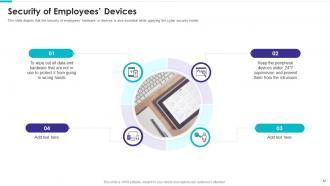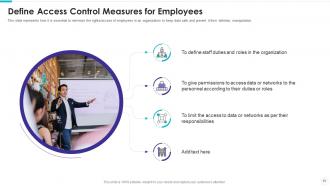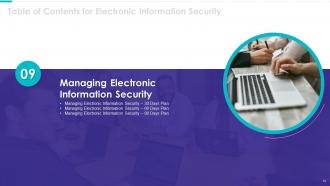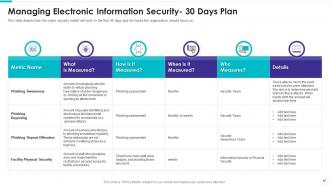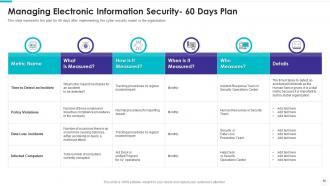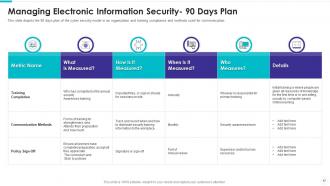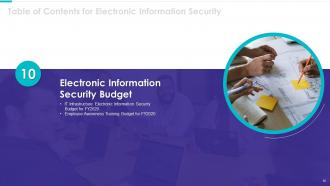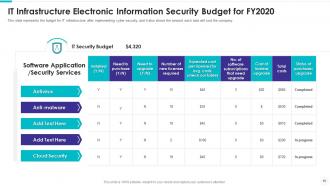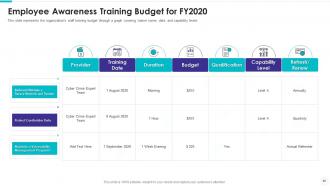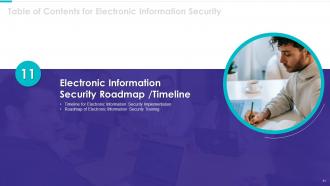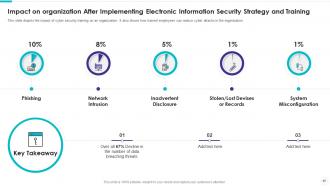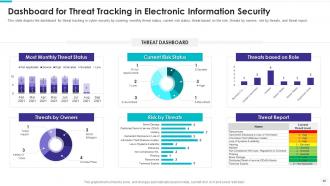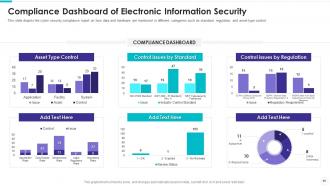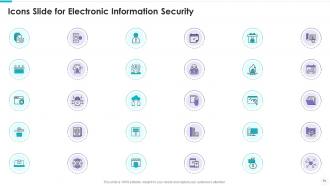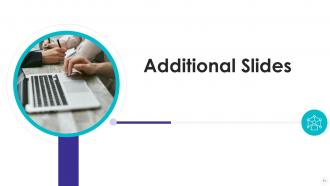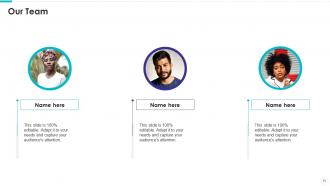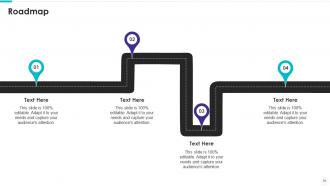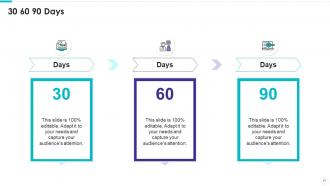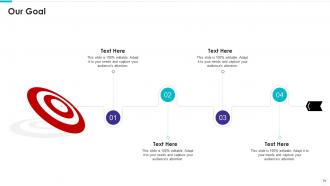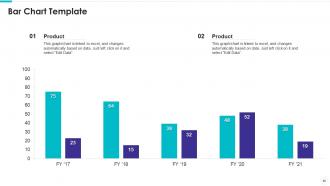Electronic information security powerpoint presentation slides
Information security is the process of protecting electronic devices such as computers, servers, mobile gadgets, data, electronic systems, and networks from cyber-attacks. Here is an efficiently designed template on Electronic Information Security that illustrates important details about cybersecurity. Incorporating this PPT, you can present and share details on the common threats against data and information systems. This network security presentation will be helpful to throw light on the current scenario of the organization, the requirement of security in different sectors, and it works. In addition, information security PPT contains the critical elements of security, risk identification and assessment, steps to mitigate those risks, and benefits of security, along with automations role in information security. Further, this data security presentation comes with a checklist to implement in the organization, a 30-60-90-day plan to manage security, and the budget to implement the same. The Information Security deck also showcases a roadmap to monitor security and a timeline to implement in the organization. Lastly, this PPT shows the effects of security implementation on the organization and dashboard for threat tracking in security. Get access now.
You must be logged in to download this presentation.
PowerPoint presentation slides
This complete deck covers various topics and highlights important concepts. It has PPT slides which cater to your business needs. This complete deck presentation emphasizes Electronic Information Security Powerpoint Presentation Slides and has templates with professional background images and relevant content. This deck consists of total of eighty one slides. Our designers have created customizable templates, keeping your convenience in mind. You can edit the color, text and font size with ease. Not just this, you can also add or delete the content if needed. Get access to this fully editable complete presentation by clicking the download button below.
People who downloaded this PowerPoint presentation also viewed the following :
Content of this Powerpoint Presentation
Slide 1: This slide displays title i.e. 'Electronic Information Security' and your Company Name.
Slide 2: This slide presents agenda.
Slide 3: This slide exhibits table of contents.
Slide 4: This slide also shows table of contents.
Slide 5: This slide depicts title for two topics that are to be covered next in the template.
Slide 6: This slide defines the meaning of cyber security and how it helps to prevent data through different methods and techniques.
Slide 7: This slide depicts the requirement of cyber security in different sectors and the percentage of attacks experienced in the medical, etc.
Slide 8: This slide depicts title for three topics that are to be covered next in the template.
Slide 9: This slide shows the organization's current situation through the total losses (in millions)experienced because of different cyberattacks.
Slide 10: This slide shows the status of malware attacks on different departments such as IT, development, accounts, and HR in the organization for the FY2021 year.
Slide 11: This slide shows the impact on the organization's financial condition due to cyber attacks in the past financial year 2022.
Slide 12: This slide depicts title for fourteen topics that are to be covered next in the template.
Slide 13: This slide represents the different elements of cyber security such as application security, network security, information security, etc.
Slide 14: This slide defines application security and categories of application threats and tools to perform application security to prevent cyberattacks.
Slide 15: This slide depicts the information security methodology and core information security principles such as confidentiality, integrity, and availability.
Slide 16: This slide represents the main principles of information security such as confidentiality, integrity, and availability, etc.
Slide 17: This slide represents the network security element of cyber security and different network security methods such as firewalls, etc.
Slide 18: This slide depicts the disaster recovery plan in the cyber security model and what strategies an organization needs to adopt.
Slide 19: This slide defines the different categories of disaster recovery plans, namely as data center disaster recovery plans, etc.
Slide 20: This slide represents the detailed process of a disaster recovery plan, how it should work, what points to keep in mind, etc.
Slide 21: This slide defines the operational security element of cyber security. It also shows the best practices for operational security.
Slide 22: This slide depicts the main steps of operational security, such as describing sensitive information, identifying potential risks, etc.
Slide 23: This slide shows the end-user education within the cyber security model. It also represents various factors that effective training plans should involve.
Slide 24: This slide defines the cloud security element of cyber security and various threats that can breach cloud security, etc.
Slide 25: This slide represents the best practices for cloud security, such as the shared responsibility model, operations management, etc.
Slide 26: This slide depicts how tasks are performed under cloud security through the framework. The framework consists of different stages.
Slide 27: This slide depicts title for three topics that are to be covered next in the template.
Slide 28: This slide depicts the main types of threats in cyber security, such as cybercrime, cyber terrorism, and cyberattacks.
Slide 29: This slide depicts the categories of recent threats that recently emerged in the United States, United Kingdom, and Australia in previous years.
Slide 30: This slide depicts the standard methods used to threaten cyber-security by cybercriminals/attackers.
Slide 31: This slide depicts title for two topics that are to be covered next in the template.
Slide 32: This slide depicts the cyberattacks surface based on different property types.
Slide 33: This slide depicts the cyber threat landscape based on cybercriminal roles/actors and the impacts of successful cyberattacks on business.
Slide 34: This slide depicts title for two topics that are to be covered next in the template.
Slide 35: This slide depicts the importance of cyber risk management strategy and procedures and factors that needs to consider.
Slide 36: This slide represents various tips or procedures that can be followed to prevent an organization's cyber security from cyberattacks or cybercriminals.
Slide 37: This slide depicts title for three topics that are to be covered next in the template.
Slide 38: This slide depicts the different benefits of deploying a cyber security model in an organization and how it can minimize the risk.
Slide 39: This slide depicts the cyber protection of an organization through artificial intelligence and how it can be helpful in threat detection, etc.
Slide 40: This slide depicts the cyber security checklist and measures an organization should take to protect data.
Slide 41: This slide depicts title for twelve topics that are to be covered next in the template.
Slide 42: This slide represents the cybersecurity awareness training program for staff, including the name of the participants.
Slide 43: This slide depicts the hardware/software update measure under the cyber security model.
Slide 44: This slide depicts the benefits of using antivirus software in the organization, different antivirus software available in the market, etc.
Slide 45: This slide depicts the importance of having strong passwords for different online accounts.
Slide 46: This slide shows the importance of minimizing the administrative and staff privilege by showing its benefits for the company.
Slide 47: This slide represents the preparation of data backup for sensitive information and how data backup should be created and stored within an organization.
Slide 48: This slide depicts what factors will be considered while preparing a recovery planning of an organization to come back to business quickly and effectively.
Slide 49: This slide represents the value of having strong IT policies within an organization regarding software, hardware, passwords, and data transfer.
Slide 50: This slide depicts secure communication within an organization and the technology to encrypt emails or data while sending or receiving them.
Slide 51: This slide depicts the importance of disposal of the data and equipment that is not in use anymore.
Slide 52: This slide depicts that the security of employees’ hardware or devices is also essential while applying the cyber security model.
Slide 53: This slide represents how it is essential to minimize the rights/access of employees in an organization to keep data safe.
Slide 54: This slide depicts title for three topics that are to be covered next in the template.
Slide 55: This slide depicts how the cyber security model will work in the first 30 days and the tasks the organization should focus on.
Slide 56: This slide represents the plan for 60 days after implementing the cyber security model in the organization.
Slide 57: This slide depicts the 90 days plan of the cyber security model in an organization and training compliance and methods used for communication.
Slide 58: This slide depicts title for two topics that are to be covered next in the template.
Slide 59: This slide represents the budget for IT infrastructure after implementing cyber security, and it also shows the amount each task will cost the company.
Slide 60: This slide represents the organization's staff training budget through a graph covering trainer name, date, and capability levels.
Slide 61: This slide depicts title for two topics that are to be covered next in the template.
Slide 62: This slide shows the timeline for cyber security model implementation in an organization and the tasks to be performed every month.
Slide 63: This slide depicts the cyber security training roadmap. It also shows the plan and guidelines to conduct an effective training program.
Slide 64: This slide depicts title for two topics that are to be covered next in the template.
Slide 65: This slide depicts the impact of cyber security training on an organization.
Slide 66: This slide represents the current status of the cyber attacks in an organization after implementing the cyber security model.
Slide 67: This slide depicts title for two topics that are to be covered next in the template.
Slide 68: This slide depicts the dashboard for threat tracking in cyber security by covering monthly threat status, current risk status, etc.
Slide 69: This slide depicts the cyber security compliance report on how data and hardware are monitored in different categories such as standard, regulation, etc.
Slide 70: This is the icons slide.
Slide 71: This slide presents title for additional slides.
Slide 72: This slide shows about your company, target audience and its client's values.
Slide 73: This slide shows details of team members like name, designation, etc.
Slide 74: This slide presents your company's vision, mission and goals.
Slide 75: This slide depicts posts for past experiences of clients.
Slide 76: This slide shows roadmap.
Slide 77: This slide depicts 30-60-90 days plan for projects.
Slide 78: This slide presents circular diagram.
Slide 79: This slide shows goals of the company.
Slide 80: This slide exhibits yearly bar charts for different products. The charts are linked to Excel.
Slide 81: This is thank you slide & contains contact details of company like office address, phone no., etc.
Electronic information security powerpoint presentation slides with all 90 slides:
Use our Electronic Information Security Powerpoint Presentation Slides to effectively help you save your valuable time. They are readymade to fit into any presentation structure.
FAQs
Cyber Security is the practice of protecting computer systems and networks from theft, damage, or unauthorized access to maintain confidentiality, integrity, and availability of data.
The different elements of Cyber Security include Application Security, Network Security, Information Security, Disaster Recovery Plan, Operational Security, End-user Education, Cloud Security, and Cyber Risk Management.
Deploying a Cyber Security model in an organization helps minimize the risk of cyber attacks, protects sensitive data, maintains business continuity, and ensures compliance with regulations.
Some measures an organization can take to prevent cyber attacks include updating hardware and software regularly, using antivirus software, having strong passwords, minimizing administrative and staff privileges, preparing data backups, creating recovery plans, having strong IT policies, and securing communication within the organization.
The different types of cyber threats include cybercrime, cyber terrorism, and cyber attacks. Recent trends include threats that have emerged in the United States, the United Kingdom, and Australia in previous years. Standard methods used by cybercriminals/attackers include phishing, malware attacks, ransomware, and social engineering.
-
Informative design.
-
Amazing product with appealing content and design.











